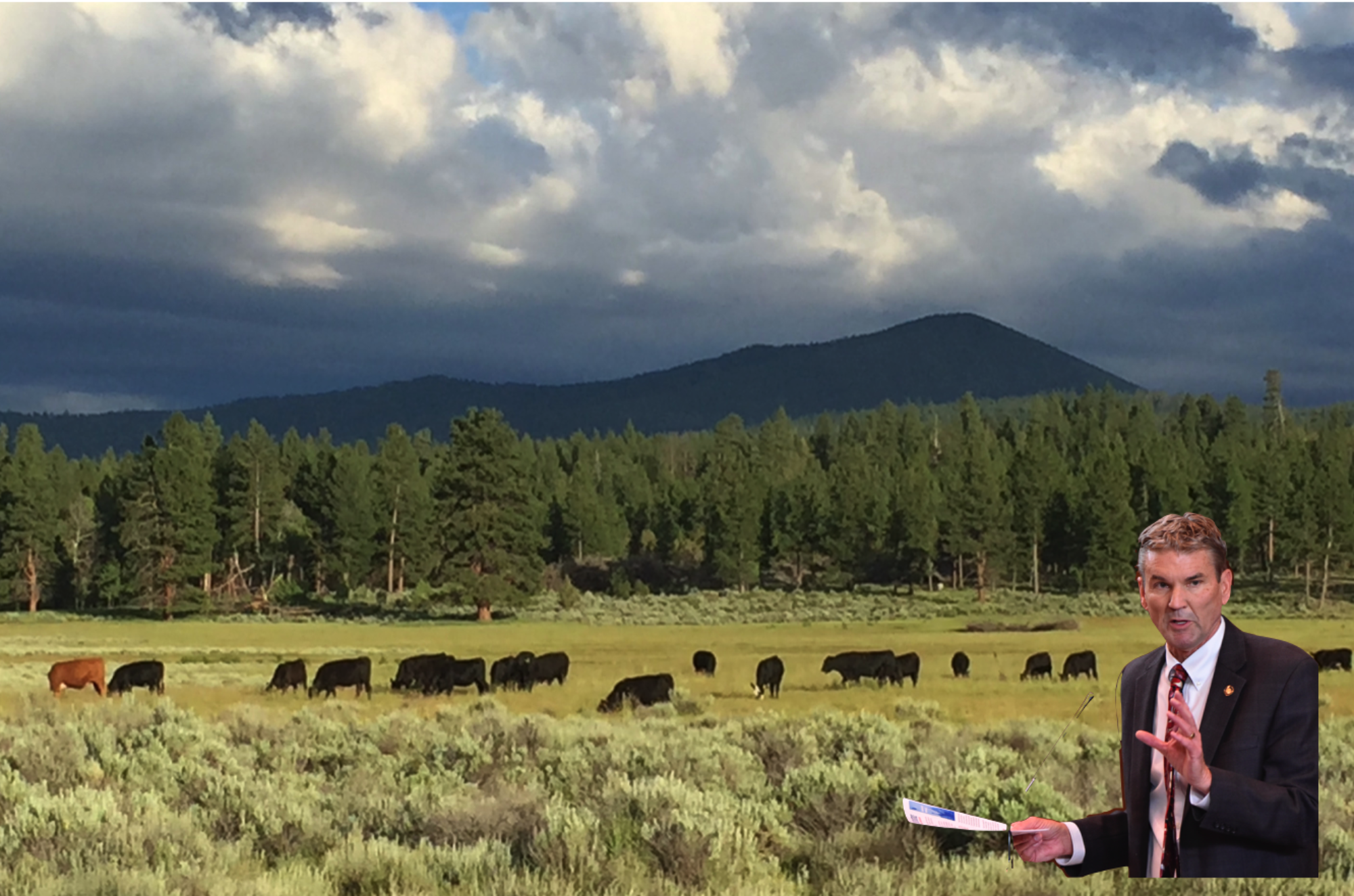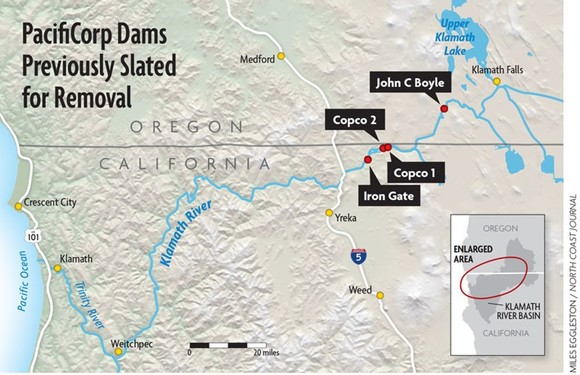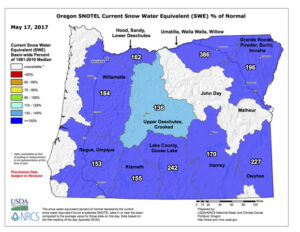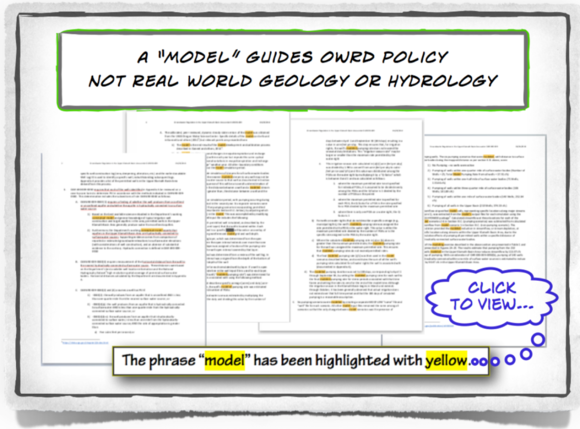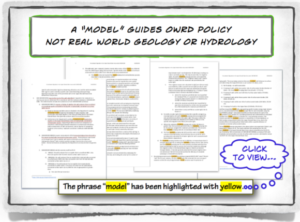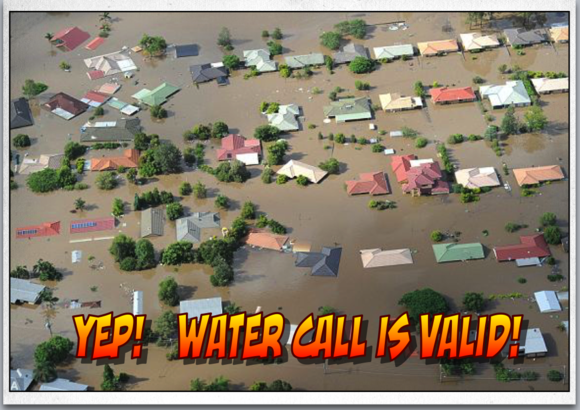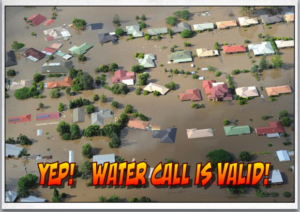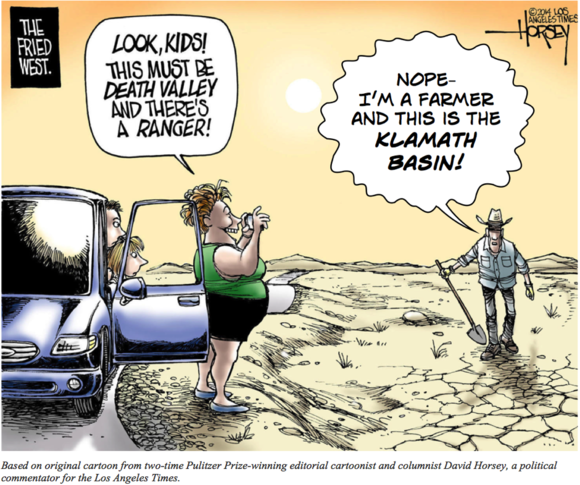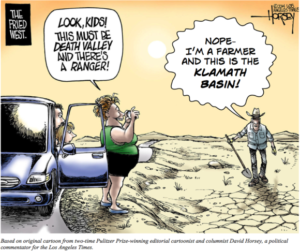The Oregon Department of Environmental Quality (ODEQ) invites the public to comment on the proposed section 401 water quality certification for the removal of the J.C. Boyle Dam, reservoir, powerhouse and all other infrastructure related to the existing Lower Klamath Project.
ODEQ will hold two public hearings on Tuesday, June 12 at 2 p.m. and 6 p.m. at Oregon Tech’s College Union Auditorium. View the full public notice for details on the public comment period at: http://www.oregon.gov/deq/get-involved/documents/070618Klamathpn.pdf.
After reading the above announcement, several people asked the same question: Didn’t Congress refuse to fund the Klamath Basin Restoration Agreement (KBRA) and isn’t that story over?
The simple answer is yes! It should be over; but, it is not.
After KBRA/KHSA was rejected by Congress the “stakeholders” decided they didn’t need to abide by Constitutional requirements set in Article I, Clause 3 which holds that two states entering into an agreement need Congressional approval. Instead, dam removal and tribal interests convinced Gov. Brown (D–CA) and Gov. Brown (D–OR) that their two states could do it, alone. Typically state governments like to use federal funding sources because the Feds continually run enormous deficits, and besides, they can just print money.
Although, these two left-coast executives want to blow the dams, several legal and regulatory issues remain unsolved. In Oregon and California multiple levels of public comment are required depending on the project’s size. The Klamath River Dam Removal is the largest US dam removal effort ever contemplated and public comments are required.
The 401 Water Quality Certification program is designed to review and evaluate the water quality impacts of projects which require federal permits for activities that may result in a waterway discharge. Specific areas of interest will be water quality, turbidity and damage to spawning habitat from sediment held behind the structures, demolition debris, or bank erosion during the dam removal process.
Scientists report that the water in the upper reaches of the Klamath Basin is “severely impaired” therefore, it follows, that poor-quality water would subsequently flow downstream and become a part of the subject matter for review. This “severely impaired” water will spill into the Klamath River system more than 200 miles from the salty Pacific. Add to this, the volume of demolition debris and the toxic sedimentary loads stored behind the current dams and you have real problems.
There is estimated to be in excess of 20 million cubic yards of accumulated sediment behind these structures. The Draft Environmental Impact Statement did not investigate the seriousness of this potential problem, address any possible mitigation efforts or the costs associated with fixing these issues.
On Tuesday, June 12th, ODEQ needs to hear our voices. They need to be made aware of a realistic assessment of the potential problems and our concerns for costly overruns, damages, clean-up and/or mitigation efforts that are currently omitted from the feel-good narrative coming from dam removal promoters.
This water quality issue is not easily side-stepped because estimates suggest 20 million cubic yards of toxic sediment exist. That in itself is the equivalent of 1 million twenty-yard dump truck loads of silt, sediment and sludge which needs to be removed. Is ODEQ willing to dump that into the river system? Where else would this sludge get dumped? I can’t wait to hear the “NIMBY/NOMR” (Not-In-My-Back-Yard/Not-On-My-Reservation) crowds erupting with those realities.
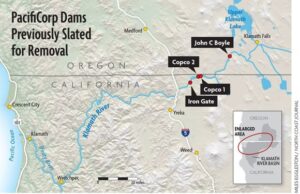
As an aside, if your company owned 100 twenty-yard dump trucks it would take 10,000 round-trip excursions to remove and discharge that much debris somewhere on our pristine landscape. What is the cost for maintaining or repairing road damage after 10,000 round-trip dump runs? Who will pay for it? The tax-payers, that’s who.
Additionally, that much sediment would require a 20 ton or larger excavator spending 10,000 hours or more of excavator time on the fill-side, with who knows what on the dispersal side. Who is going to pay for that? The tax-payers, that’s who.
The easy answer seems to be, “Let it wash out to the Pacific Ocean,” then, only the downstream salmon fisheries will bear the burden from this harmful sludge. Sure, let that much sediment and debris clog the river, no problem. Look at where the mouth of this river systems meets the Pacific, how much debris would it take to fill this in? Who will pay for the dredging of the river after this happens. The tax-payers, that’s who.
Removal of the dams is a bad idea because grid capacity will be lost; reservoirs will be destroyed; boating, fishing and recreational opportunities will be diminished; land-values will be devastated; and flow regulating mechanisms will be demolished, aside from the resulting debris and sediment that will be washed down-stream. Without the dams and their respective reservoirs water won’t be available for flushing-flows or regulating the volume of dilution flows. The result will be degraded river conditions (low dissolved oxygen, increased primary productivity, elevated pH, unionized ammonia issues, destruction of spawning habitat, increased turbidity, etc., etc.
ODEQ partially recognizes these issues and has established a time compliance schedule of 24 months. This means the Klamath River Renewal Corporation (KRRC) gets to spend two years doing things that none of us could ever do. After all, they are paying a fee and getting their permit to pollute. The real question is what happens when this estimate goes awry? What corrective actions will be required? Who will pay for these efforts several years into the future? The tax-payers, that’s who.
 |
The problem is that both governors have their hands clasped to the money-end of the environmental train that will needlessly waste and misallocate our respective state’s scarce financial resources. The story is composed of equal parts fairy tale and naiveté with a generous portion of political agenda lathered with public funds taken from future taxpayers. |
I refer to future costs because today’s accumulated funding only amounts to $450 million. Part of the money, $200 million comes from PacifiCorp’s already collected customer surcharge and the other $250 million comes from California Proposition 1 Bonding. Yet, the original dam removal estimates were $1.4 billion, i.e., $1,400 million. How did the bureaucrats down in Dam Removal Central magically find $1 billion in cost savings?
They didn’t. They are just leaving those items out of the project’s current scope. Those extra costs will remain off the books and temporarily hidden. Think of it like a construction project change-order. The narrative will be, “We need this thing done… we’re already well underway… it will only cost $xxx… and the world will be a better place for the children.”
Environmental-political activists know that legislative power is the key to successful political plunder. They gloss over the inconsistencies between their storyline and the science, forcing public policy on populations who disagree (deniers). Apparently, this poses no problem because there is plenty of money to be made through legislated benefits and senseless government mandates. The needless destruction of useful technologies for capturing nature’s cleanest energy source – hydropower – is of no real concern because their agenda is being realized.
In closing, I strongly encourage you to join me and show up on June 12th. ODEQ needs to hear our voices, after all, we will get stuck with the bill.
Remember, if we don’t stand for rural-Oregon values and common sense – No one will.
Best Regards,

Dennis Linthicum
Oregon State Senate 28
